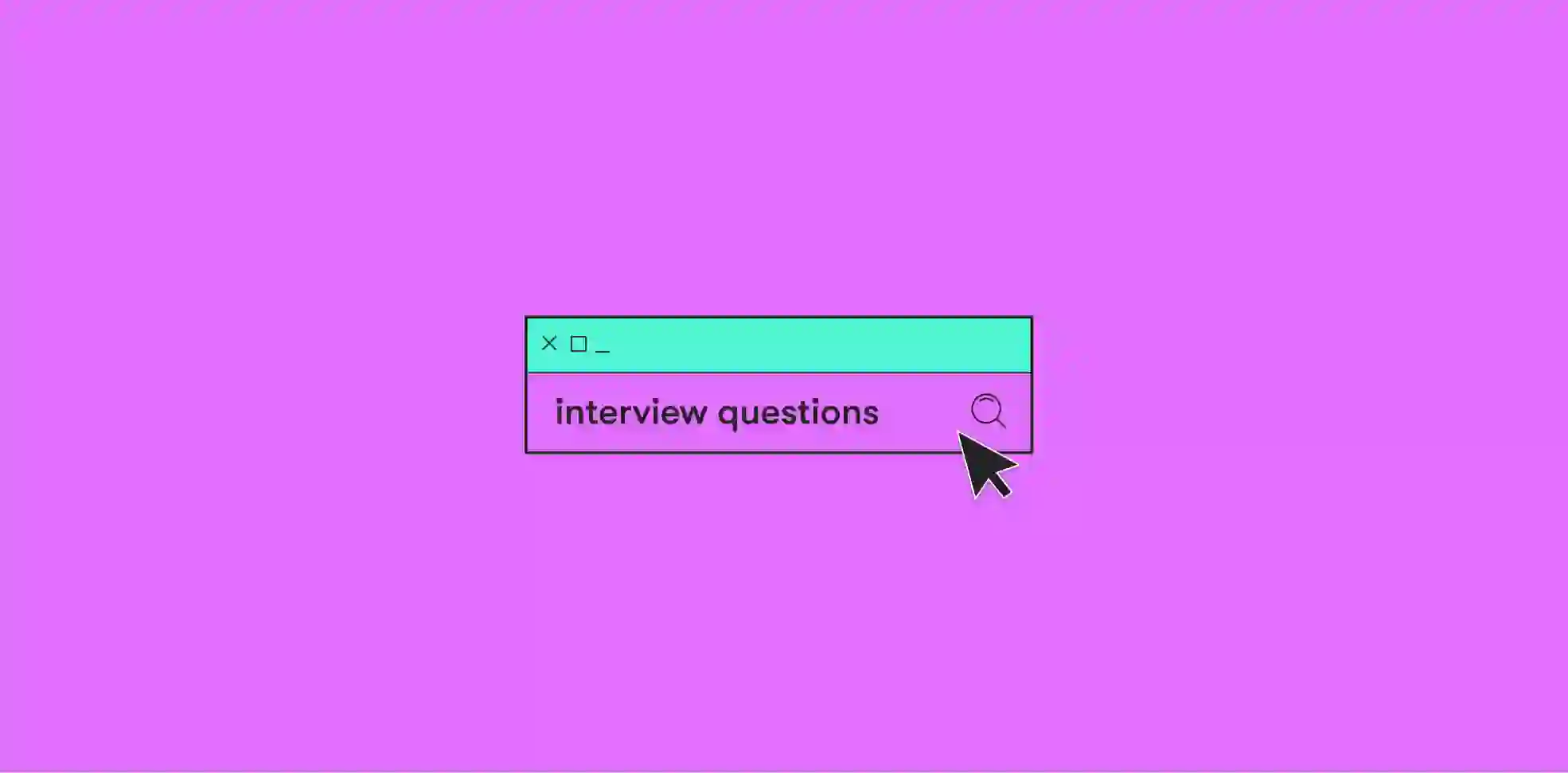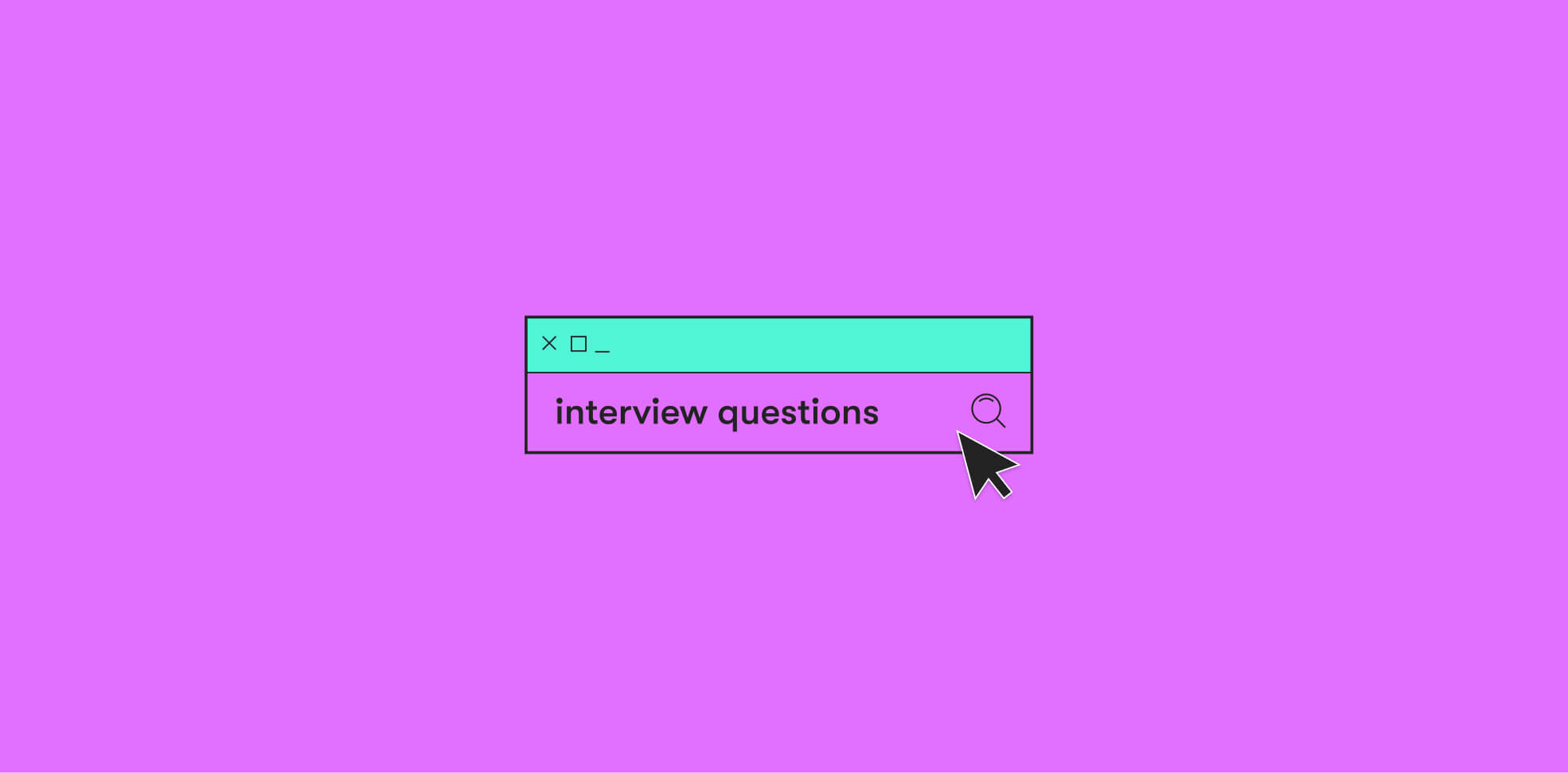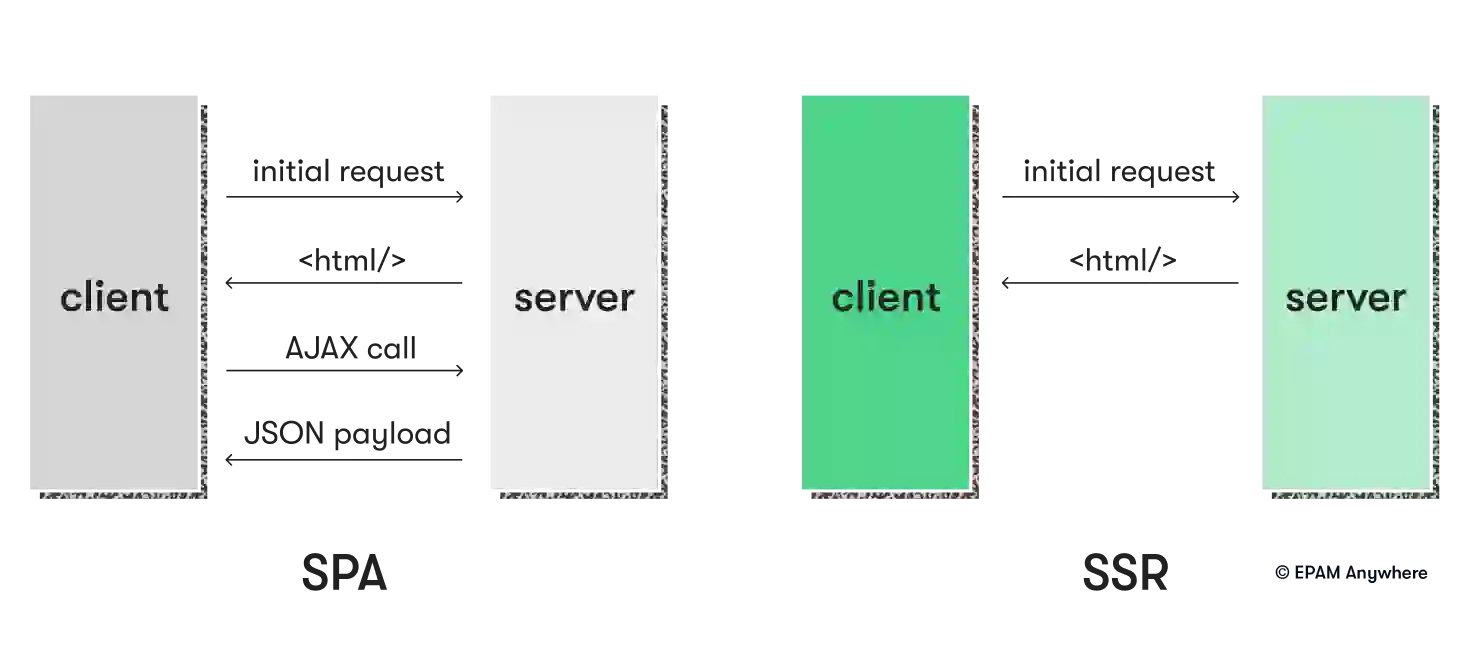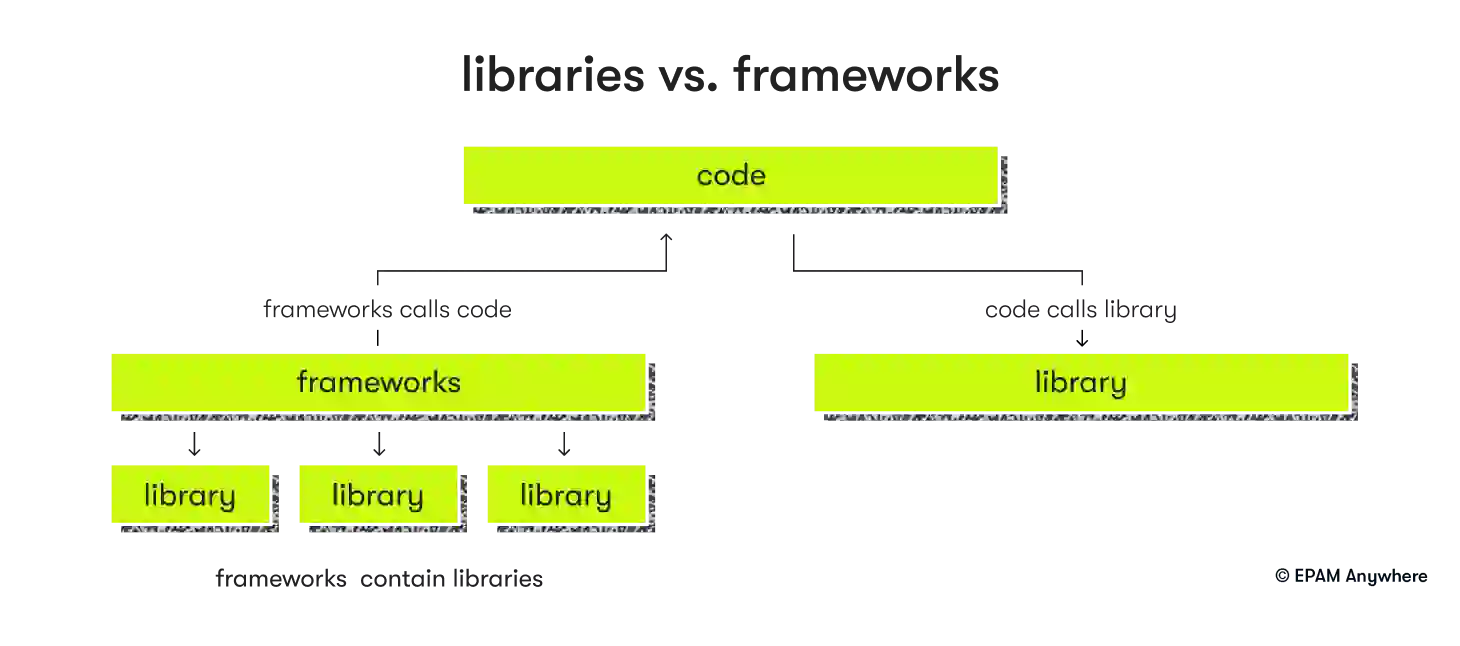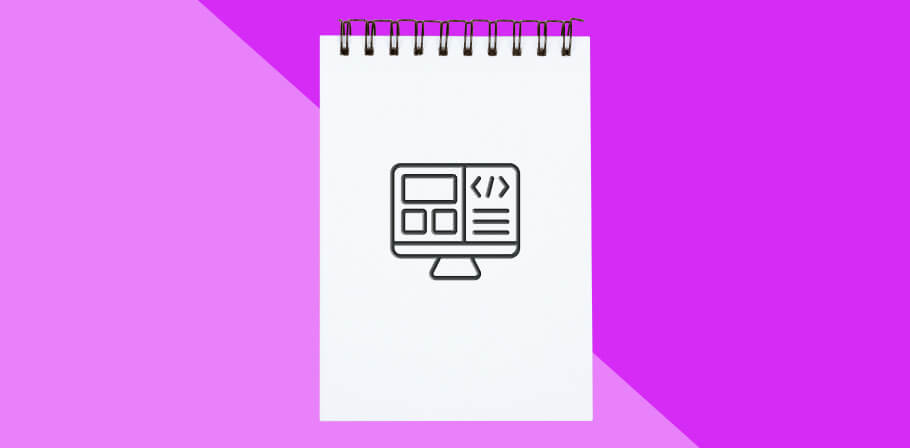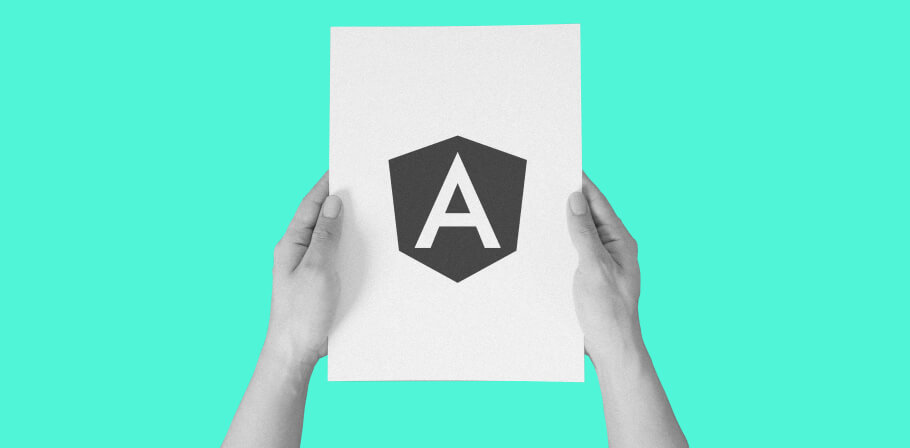When applying for front end developer jobs, you need to be well-prepared to give the most comprehensive answers and stand out as a senior-level candidate. While preparing for your next technical interview, use these questions that are commonly asked by companies hiring JavaScript developers.
In this article, Nikita Shevtsiv, Senior Software Engineer and Certified Technical Interviewer at EPAM Anywhere, has compiled the 11 most common interview questions for senior front end developers. Also included are the answers to the questions with relevant tips that will help you get ready for your next interview at EPAM Anywhere or elsewhere.
ready for a career adventure?
Unleash the full potential of remote work. Enjoy flexibility and career growth as a remote software engineer at EPAM Anywhere. Send your CV and we'll match our open positions with your skills.
1. How can you decide to use Angular, React, or Vue based on the project size?
For small projects where the application is simple and doesn't require a lot of complex functionality, React or Vue would be good choices. Both frameworks are lightweight and easy to learn, making them great for small projects.
For medium-sized projects where the application requires more complex functionality, Angular or React might be a better choice. Angular is a complete framework with many built-in features, making it great for larger, more complex projects. React, on the other hand, is highly modular and can be used to build complex applications by integrating with other libraries and tools.
For large-scale enterprise projects, where the application is highly complex and requires a lot of features, Angular is often the preferred choice. Angular's extensive built-in functionality and robust architecture make it ideal for large-scale applications. Additionally, Angular provides strong support for TypeScript, a powerful programming language that can help ensure code quality and maintainability in large projects.
It's important to note that the choice of JavaScript framework ultimately depends on various factors, including project requirements, team skill set, and personal preferences. Evaluating each framework's strengths and weaknesses is essential to determine which is the best fit for your project.
2. What are the main differences between SPA and SSR?
SPA (Single Page Application) and SSR (Server Side Rendering) are two different approaches to building web applications. Here are some key differences between them:

- Architecture: SPA is a client-side application where the entire web application is loaded in the browser and all the interactions happen on the client side. Conversely, SSR is a server-side application where the server generates the HTML for the web page and sends it to the browser.
- Performance: SPA provides a better user experience, as it loads the page once and then dynamically updates the content as the user interacts with the app. This reduces the amount of data transferred between the server and the client, resulting in faster page loads. SSR, on the other hand, provides faster initial page load times, as the server renders the HTML on the initial request.
- SEO (Search Engine Optimization): SPA has poorer SEO compared to SSR, as most search engines struggle to index client-side rendered pages. SSR, on the other hand, provides better SEO, as the server generates the HTML for the web page, which can be easily crawled by search engines.
- Development: SPA is generally easier to develop, as the entire application logic is on the client side. SSR requires more server-side development and configuration.
- Scalability: SPA can be easily scaled horizontally by adding more servers to handle the increased load. SSR requires more powerful servers to handle the rendering of the HTML on the server side.
- Security: SPA can be more vulnerable to cross-site scripting (XSS) attacks, as most of the application logic is executed on the client side. SSR provides better security, as most of the application logic is executed on the server side.
- Offline functionality: SPA can provide better offline functionality, as most of the application logic and data is cached on the client side. SSR, on the other hand, requires a network connection to render the HTML on the server side.
Overall, SPA and SSR are both valid approaches to building web applications, and the choice between them depends on the specific requirements of the application.
3. Describe the life cycle of any task in front end development
The life cycle of a task in front end development can vary depending on the project management methodology being used, but it generally follows the following stages:
- Requirement gathering: The task starts with gathering the requirements from the client or stakeholders. This involves understanding the features and functionalities that are required to be implemented in the front end.
- Planning: After gathering the requirements, the next stage is planning. This involves breaking down the task into smaller sub-tasks, estimating the time required for each of them, and deciding the order of execution.
- Design: In this stage, the design of the front end is created. This includes creating wireframes, mockups, and prototypes. Designers may use tools like Adobe Photoshop or Sketch for designing the front end.
- Development: Once the design is ready, developers start working on the actual development of the front end. This involves writing code using HTML, CSS, and JavaScript. Developers may use frameworks like React or Angular to speed up the development process.
- Testing: After the development is complete, the front end is tested to ensure that it meets the requirements and functions as expected. This involves testing for usability, compatibility, and performance.
- Deployment: Once the front end is tested and approved, it is deployed to a server or a hosting platform. This involves setting up the necessary infrastructure, configuring the server, and uploading the front end files.
- Maintenance: After deployment, the front end needs to be maintained to ensure that it continues to function properly. This involves fixing bugs, adding new features, and making necessary updates.
Throughout the life cycle of the task, communication between the development team, the client, and other stakeholders is essential to ensure that the project is completed successfully.
4. Explain the sense of using several .env files. What types of environments do you know?
Using multiple .env files in a software project is a common practice to manage different environment variables required by the application.
Environment variables are dynamic values that can be set outside of the application's code and configuration files, allowing developers to customize the behavior of the application for different environments, such as development, testing, staging, and production.
By using multiple .env files, developers can define environment-specific variables, making it easier and more practical to manage and maintain the application across different environments. For example, a development environment might use a different database or API key than the production environment.
The most common types of environments include:
- Development: This environment is used by developers to write, test, and debug code. It typically uses a local database and other resources to simulate the production environment.
- Testing/Staging: This environment is used to test the application's behavior in an environment that’s similar to the production environment. It is often used to test new features, updates, and bug fixes before deploying them to the production environment.
- Production: This is the environment where the application runs and is accessible to end users. It typically uses the same resources and configurations as the testing/staging environment, but with additional security and monitoring measures in place to ensure reliability and availability.
5. Explain how the JavaScript event loop works
The JavaScript event loop is a mechanism that allows JavaScript to handle asynchronous events such as user interactions or network requests while maintaining its single-threaded execution model. Here's how it works:
- The event loop continuously checks for new events in the event queue.
- When an event is added to the queue, it's assigned a priority based on its type and the order in which it was added.
- The event loop takes the highest-priority event from the queue and executes its associated callback function.
- During the execution of the callback function, other events can be added to the queue.
- Once the callback function is finished, the event loop moves on to the next event in the queue and repeats the process.

Here's an example scenario to illustrate how this works:
- A user clicks a button on a webpage, triggering a "click" event.
- The "click" event is added to the event queue with a high priority.
- The event loop detects the "click" event in the queue and executes the associated callback function.
- The callback function updates the webpage with new content and makes an asynchronous network request to fetch additional data.
- The network request is added to the event queue with a lower priority than the "click" event.
- The event loop continues to execute events from the queue, and once it reaches the "fetch" event, it initiates the network request.
- When the network request is complete, a new event is added to the queue with a higher priority than the remaining events.
- The event loop detects the new event, executes its callback function, and updates the webpage with the fetched data.
Overall, the event loop allows JavaScript to handle multiple events and tasks in a non-blocking and efficient manner, making it an essential component of modern web development.
6. Do we have to use SCSS/SASS for every project? Is the usual CSS enough?
No, you do not have to use SCSS/SASS for every project, and regular CSS is often enough.
SCSS/SASS is a preprocessor for CSS that allows you to write CSS with variables, nested selectors, functions, and more. It can help you write more organized and maintainable CSS, but it is optional for some projects.
If you are working on a small project or a project that does not require complex CSS, regular CSS may be sufficient. However, if you’re working on a larger project with many styles, variables, and complex selectors, SCSS/SASS is a better choice to help keep your code organized and maintainable.
Ultimately, the decision to use SCSS/SASS or regular CSS depends on the specific needs and requirements of your project, as well as your personal preference and coding style.
7. How do you approach integrating third-party APIs into a front end application?
Integrating third-party APIs into a front end application involves a few key steps:
- Identify the APIs you want to integrate: You first need to determine which APIs you want to use and understand their capabilities, limitations, and requirements. It's important to thoroughly read the API documentation and understand the parameters, data formats, and authentication requirements.
- Determine the integration method: Depending on the API, you may need to choose between client-side or server-side integration. For example, if you are integrating with a payment gateway, it's typically safer and more secure to handle the API requests on the server side rather than exposing sensitive payment data on the client side.
- Create API requests: To communicate with the API, you need to make HTTP requests to the API endpoint. This can be done using tools like the Fetch API or Axios library. You will need to provide the appropriate parameters in the request, such as authentication tokens or data to be sent to the API.
- Process API responses: Once you've sent your request, the API will respond with data. You'll need to handle the response appropriately, depending on the data format returned by the API. You might parse the response data and display it in your application or use it to make further API requests.
- Handle errors: It's important to handle API errors gracefully in your front end application. This includes handling HTTP status codes and displaying appropriate error messages to the user.
- Test and debug: Finally, thoroughly test your API integration to ensure it's functioning as expected. Use tools like Postman to test your API requests and verify that you're receiving the expected responses. Debug any issues that arise in your code, and make sure to handle any edge cases or error scenarios.
Overall, integrating third-party APIs into a front end application requires careful planning, implementation, and testing to ensure secure and reliable integration.
8. Can you describe your experience with debugging tools and techniques for front end development?
Debugging tools and techniques are essential for front end development to identify and fix bugs in the code. Some of the most commonly used debugging tools and techniques for front end development include:
- Browser developer tools: Most modern browsers come with built-in developer tools that can help developers debug their front end code. The developer tools provide various features such as inspecting HTML, CSS, and JavaScript, debugging JavaScript code, and monitoring network traffic.
- Console logging: Console logging is a simple technique used by developers to print messages to the browser console. This technique can help developers identify the flow of the code and detect errors.
- Code breakpoints: Code breakpoints allow developers to pause the code execution at specific lines of code. This technique is useful when developers want to inspect the state of the code and track the flow of the execution.
- Testing: Testing is another essential technique that developers can use to identify bugs in their front end code. Unit tests, integration tests, and end-to-end tests can help developers catch errors early in the development process.
- Code reviews: Code reviews can help developers identify potential bugs in their code. Having a fresh set of eyes reviewing the code can often lead to the identification of errors that might have been missed by the original developer.
Using a combination of these debugging tools and techniques can help front end developers identify and fix bugs in their code more efficiently.
9. How do you ensure cross-browser compatibility for your front end applications?
Ensuring cross-browser compatibility is essential for any front end application to provide a seamless user experience across different devices and platforms. Here are some practices that can help ensure cross-browser compatibility:
- Use a CSS reset or normalize stylesheet to ensure consistent default styling across different browsers.
- Use modern web development practices such as responsive design, CSS flexbox, and grid layout, which work well across different browsers.
- Test your application on different browsers and platforms using tools such as BrowserStack or Sauce Labs.
- Use feature detection instead of browser detection to determine which features are available on a particular browser, and provide fallbacks for unsupported features.
- Use polyfills or shims to provide support for missing features or APIs on older browsers.
- Minimize the use of browser-specific features and APIs, and use standardized APIs whenever possible.
- Regularly update and maintain your application to ensure compatibility with the latest browser versions.
Overall, it's important to keep in mind that cross-browser compatibility is an ongoing process, and it requires a combination of testing, development, and QA best practices and maintenance to ensure a seamless user experience across different browsers and platforms.
10. Can you describe the process for developing a user interface from scratch?
When asked process-related sr front end developer interview questions, break things down into clear stages. Here are some steps that are commonly followed in UI development:
- Define the user requirements: The first step is to define the user requirements for the UI. This can be done by conducting user research, such as interviews and surveys, to understand the needs, preferences, and expectations of the target audience.
- Sketch the layout: Based on the user requirements, the next step is to sketch a rough layout of the UI. This can be done using paper and pencil or a wireframing tool. The layout should focus on the key elements and functions that the user will interact with.
- Design the visual elements: Once the layout is finalized, the next step is to design the visual elements of the UI, such as colors, typography, and icons. It's important to ensure that the design is consistent with the branding of the product or service.
- Develop the UI: After the design is complete, the UI development process begins. This involves coding the HTML, CSS, and JavaScript to create the UI components and functionality.
- Test the UI: Once the UI is developed, it should be tested to ensure that it is user-friendly, functional, and meets user requirements. This can be done through user testing and usability testing.
- Iterate and improve: Based on the feedback from testing, the UI may need to be iterated and improved. This can involve making changes to the layout, design, or functionality of the UI.
- Launch the UI: Once the UI is finalized and tested, it can be launched to the users.
These are some of the key steps involved in developing a UI from scratch. However, the exact process can vary depending on the project requirements, resources, and timeline.
11. Angular is a framework, React is a library. What is the difference between a framework and a library?
A library is a collection of pre-written code that can be reused to perform specific tasks, such as creating user interfaces or handling network requests. A library typically provides a set of functions or classes that can be called by the developer's code to accomplish a particular task. Libraries are designed to be flexible and can be used in a variety of applications.
On the other hand, a framework is a more comprehensive set of tools and conventions that provides a structure for building an entire application. A framework typically includes a set of libraries and tools, as well as a set of rules and best practices that guide the development process. Frameworks provide a more prescriptive approach to application development, and developers must often follow the framework's guidelines closely to ensure that their code integrates correctly with the rest of the application.

In summary, while both libraries and frameworks provide pre-written code that can be used to build applications, the main difference is in their scope and level of abstraction. Libraries are more flexible and can be used for a variety of tasks, while frameworks provide a more comprehensive set of tools and conventions for building entire applications.
Find your senior front end developer remote job at EPAM Anywhere
If you’re on the lookout for remote front end developer jobs, you can find exciting opportunities at EPAM Anywhere. Working remotely and building a rewarding career in tech can be the next career move that’ll bring many benefits and improvements to your life.
With EPAM Anywhere, you’ll have skill advisors guiding your way to skill development and improvement, along with a supportive global community of tech professionals who will assist you in paving the way for career development. Apply for EPAM Anywhere’s remote JavaScript developer jobs to build a remote career on your own terms.

With 5+ years of software development experience, I specialize in cross-stack development with React Native, Angular, and NestJS as well as presales PoC development. I'm an EPAM University coordinator and develop React training programs. I like sharing my experience to make the learning process easier for future developers.
With 5+ years of software development experience, I specialize in cross-stack development with React Native, Angular, and NestJS as well as presales PoC development. I'm an EPAM University coordinator and develop React training programs. I like sharing my experience to make the learning process easier for future developers.
Explore our Editorial Policy to learn more about our standards for content creation.
read more